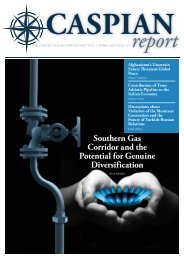You also want an ePaper? Increase the reach of your titles
YUMPU automatically turns print PDFs into web optimized ePapers that Google loves.
MANFRED HAFNER<br />
24<br />
Notwithstanding the strong political<br />
commitment of the five transit countries<br />
and the unprecedented political<br />
support of the EU and the US, the<br />
Nabucco project ultimately failed,<br />
mainly because of commercial and<br />
financial reasons: a very large scale<br />
pipeline project combined with a<br />
hugely uncertain demand outlook<br />
and the potential competition of<br />
South Stream. Moreover, the project<br />
promoters were mainly mid-size<br />
companies who have to rely on project<br />
finance and bank loans, and the<br />
banks ask for guarantees and long<br />
term ship or pay contracts which<br />
the market could not deliver. Furthermore,<br />
another major element of<br />
uncertainty for the Nabucco project<br />
was related to the fact that -with the<br />
only exception of Azerbaijan- all the<br />
potential suppliers were facing major<br />
difficulties to materialize their<br />
willingness to evacuate gas to Europe<br />
via Turkey.<br />
THE EVOLUTION OF THE<br />
SOUTHERN GAS CORRIDOR<br />
BEYOND NABUCCO: TANAP AND<br />
TAP<br />
Taking into consideration the insurmountable<br />
commercial and financial<br />
barriers that the Nabucco<br />
project was facing, Azerbaijan<br />
-clearly the gas producing country<br />
most interested on the development<br />
of the Southern Gas Corridor 12<br />
- completely reshaped the Southern<br />
Gas Corridor game in 2011 by rapidly<br />
conceptualizing its own infrastructure<br />
project to evacuate future<br />
gas flows from Shah Deniz Phase II<br />
to Turkey: the Trans Anatolian Natural<br />
Gas Pipeline (TANAP).<br />
TANAP, a projected 2,000 km-long<br />
gas pipeline with a capacity of 16<br />
bcm/year, has been designed to supply<br />
6 bcm/year to Turkey by 2018<br />
and 10 bcm/year to Europe by 2019.<br />
TANAP will run from the Georgian-<br />
Turkish border to the Turkish-Greek<br />
border, but the exact route of the<br />
pipeline is not clear yet. TANAP will<br />
receive its gas from the South Caucasus<br />
Pipeline (SCP), a pipeline already<br />
evacuating gas from the Azerbaijani<br />
Shah Deniz field to Turkey,<br />
which will be expanded in order to<br />
accommodate the new volumes of<br />
gas coming from Shah Deniz Phase<br />
II and going to TANAP.<br />
On the contrary of Nabucco, TAN-<br />
AP was not born as a multilateral<br />
project but rather as a producer<br />
driven bilateral project between<br />
Azerbaijan and Turkey. The initial<br />
act of the project -occurred in December<br />
2011- was the signature<br />
of a Memorandum of Understanding<br />
(MoU) between Azerbaijan and<br />
Turkey establishing a consortium<br />
to build and operate the pipeline. 13<br />
This initial step was then followed<br />
by the signature of a binding intergovernmental<br />
agreement on TANAP<br />
made by Azerbaijan’s President Aliyev<br />
and Turkey’s (at the time) Prime<br />
Minister Erdoğan in June 2012. 14<br />
Of course this bilateral relation was<br />
not symmetric, but rather unbalanced<br />
in favour of Azerbaijan. In fact,<br />
the State Oil Company of Azerbaijan<br />
(SOCAR) was initially set to hold an<br />
80 percent stake in the project, leaving<br />
only the remaining 20 percent<br />
to the Turkish partners (15 percent<br />
to BOTAŞ and 5 percent to TPAO).<br />
12.<br />
Not only because of the investments already made on its Shah Deniz natural gas field, but also<br />
because of the need to reach a final investment decision for Shah Deniz Phase II (a decision<br />
that finally arrived on December 17, 2013).<br />
13.<br />
“Turkey and Azerbaijan Sign MoU for TANAP Pipeline”, in Middle East Economic Survey, 9<br />
January 2012.<br />
14.<br />
“TANAP Project, the Silk Road of Energy, Has Been Signed”, http://www.tanap.com, 26 June<br />
2012.










